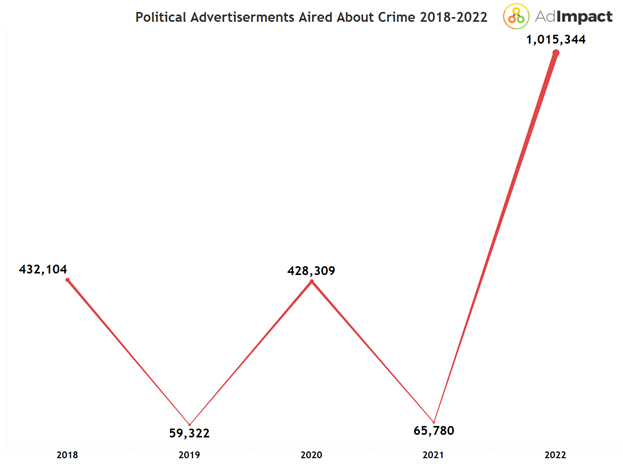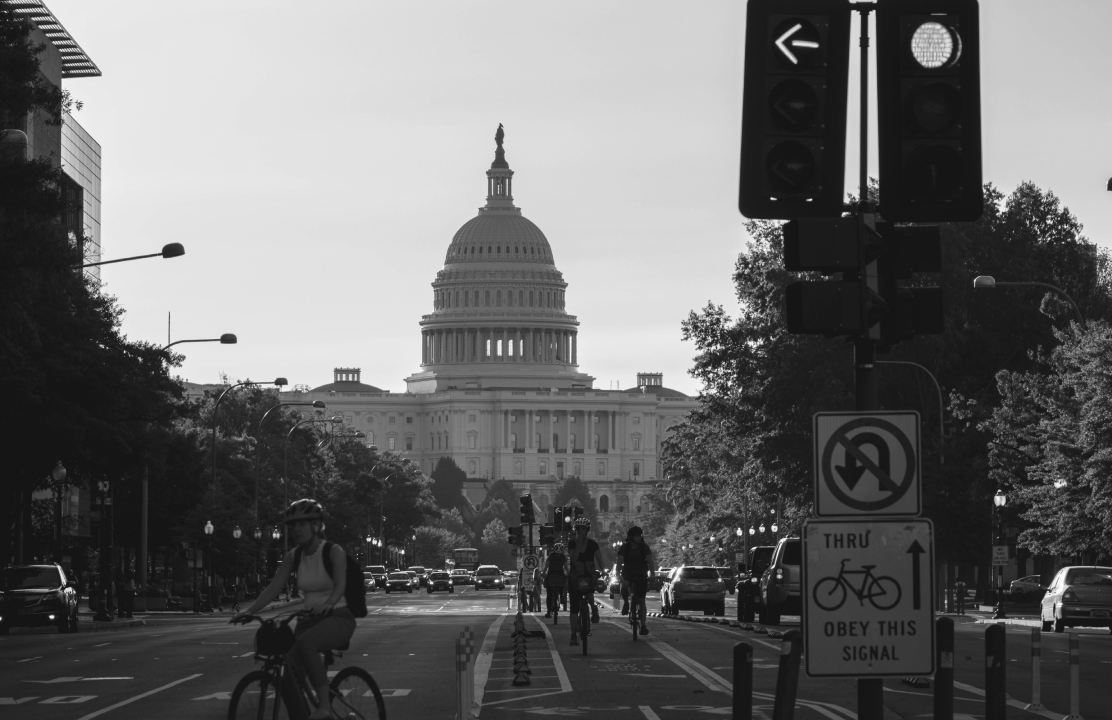Written by Ethan Mort
Cook Political Report editor David Wasserman described the 2022 Midterm Election as “the craziest election night ever.” The night saw some extreme overperformances by Democrats in Republican districts and vice-versa for Republican candidates. A few weeks later, Wasserman would tweet out that while Democrat Mary Peltola won a Trump +10 seat, five other Democrats lost Congressional districts which voted for Biden by a margin of +10. This case study analysis will look at two Congressional districts that were rated as “Lean R” in which the Democratic candidate either won (WA CD-03) or came within 500 votes of winning a safe R seat (CO CD-03), and an election in which a Republican prevailed in a district 538 rates as D+8 (NY CD-17). WA CD-03 and CO CD-03 lacked involvement from national issue groups and featured political ad messaging focused on abortion, an issue which was not prevalent in the districts’ past elections. In NY CD-17, national issue groups did get involved, as political ad messaging targeted abortion, crime, and inflation.
Spending and Messaging in Democratic Over Performances
In WA CD-03, Democratic candidate Marie Glusenkamp Pérez defeated Republican Joe Kent with a 1.5% vote margin in a district that 538 rated as R+11. In a nonpartisan primary system where the top two vote getters advance to the general election, Kent secured more votes than the Republican incumbent, Jaime Herrera Beutler. Democrats held a major spending advantage over Republicans in the general: $2.6M to $800K. Unlike in past years where the Republican candidate in WA CD-03 received political ad support from the NRCC, Kent received no support from any Republican issue group. Meanwhile, Glusenkamp Pérez received a total of $500K in support from House Majority PAC and Together for Progress.

The WA CD-03 general election saw the least amount of political ad spending in 2022 compared to 2018 and 2020. Despite that, this year saw the largest partisan spending gap of the last three cycles. In 2022, Democrats spent $1.8M more than the Republicans. In 2020, Republicans outspent Democrats by $1.6M and in 2018, Democrats outspent Republicans by $700K.

There was a stark contrast in political ad messaging between 2020 and 2022 in this district. The most significant distinction between the two elections was the emergence of ads about abortion and inflation this cycle. In the past, WA CD-03 voters saw no ads primarily about abortion. In 2022, 55% of all ads for the Congressional election mentioned abortion. Another notable trend was the decline in ads primarily focused on the Coronavirus or former President Donald Trump.
Glusenkamp Pérez and Democrat issue groups were the only advertisers to focus on abortion. In this ad, Pérez attacked Kent for his support of a national abortion ban. Abortion played a key role in Glusenkamp Pérez’ political ad messaging, where 66% of Glusenkamp Pérez’ ads mention abortion. Meanwhile, Kent’s most discussed issue was inflation, as 74% of his ads mentioned it, including this one.
Colorado saw another race in which the Democrat vastly outperformed expectations in a district that typically favored Republicans. While Democrat Adam Frisch failed to unseat Lauren Boebert in CO CD-03, he came within 500 votes of winning a race not even listed as a potential flip on the Cook Political Report House Rating List. 538 rates the district as R+15. CO CD-03 attracted very little national attention when it came to political ad spending. While House Majority PAC, the DCCC, the NRCC and Congressional Leadership Fund each spent at least $1M in the district in 2020, none of these groups spent money towards the race this cycle. Democrats outspent Republicans by $1.4M in 2020. That advantage reversed in 2022, as Republicans outspent Democrats by $400K.

Like Glusenkamp Pérez did in Washington, Frisch released ads primarily about abortion. The big difference between Glusenkamp Pérez and Frisch, however, was that ads mentioning abortion only made up 23% of Frisch’s total ads. Instead, his most discussed subject was touting his bipartisanship, as seen in an ad where he proclaimed he "won’t be a yes-man for Trump, nor Biden.” Referencing “America First,” Frisch released ads claiming he was “Colorado First” and Boebert was anti-Colorado.
Boebert revised her political ad messaging strategy in 2022. In 2020, Boebert mentioned progressive Democrat Alexandria Ocasio-Cortez in 41% of her ads. In 2022, Boebert mostly shied away from name-dropping Democrats in her ads. The only Democrat she mentioned was Speaker Pelosi, who got named in 18% of her airings. In 2022, Boebert instead released ads concerned about Colorado’s energy production and preserving Colorado’s forests and water supply.
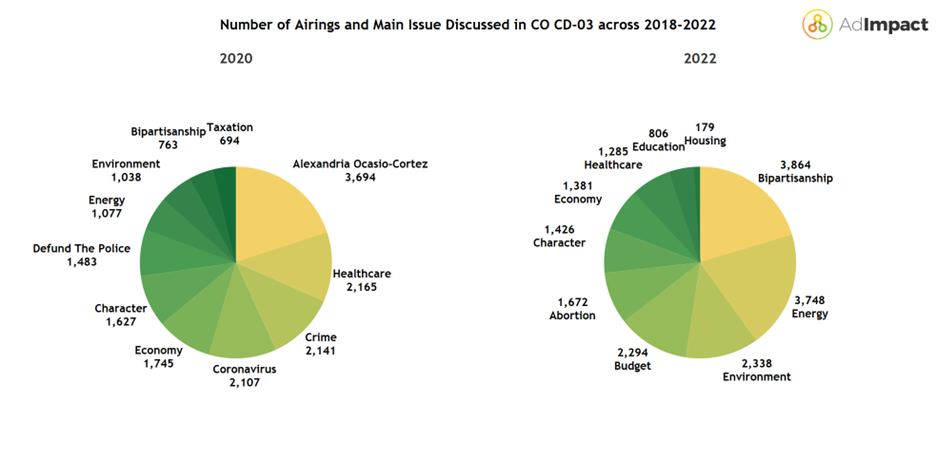
In both of these races that unexpectedly swung heavily Democratic, Congressional candidates mentioned abortion often in political ad messaging when there was no mention of abortion in 2018 or 2020. This development wasn’t just isolated within CO CD-03 and WA CD-03. Across the nation, ads about abortion flooded the airwaves, and it increasingly became one of the Democrats’ top issues they campaigned on. For instance, 52% of all ads aired by the DCCC and House Majority PAC mentioned abortion.
Political ads mentioning abortion increased in 2022, due to the recent Dobbs Supreme Court Decision. In 2020, 2.2% of all broadcast ads mentioned abortion. In 2022, that number skyrocketed to 19%, meaning nearly every one in five political ads this cycle mentioned abortion.
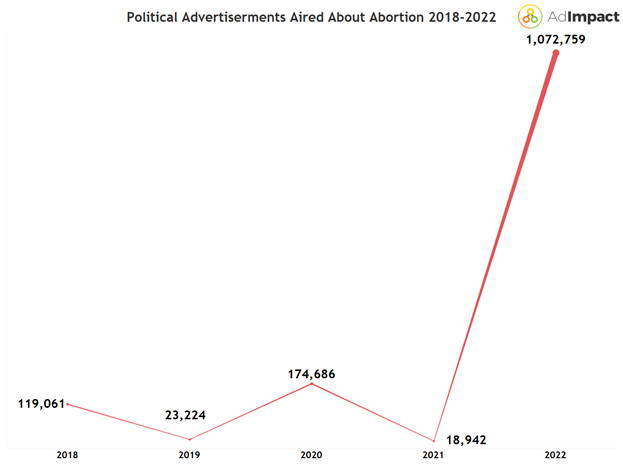
Spending and Messaging in NY CD-17
Democrats weren’t the only overperformers in Congressional Districts thought to be firmly in their opponent’s column. Congressional Republicans also scored some surprising wins this year. One example was in NY CD-17, where Republican Michael Lawler upset Democratic incumbent, Sean Patrick Maloney, the chair of the DCCC. Lawler won with a margin of 1.2% in a district 538 rated as D+8. Cook Political Report had this race as “Lean Democratic” up until October, when it became a tossup.
Maloney wasn’t NY CD-17’s Representative to begin with. Instead, Maloney was originally in NY CD-18 and then jumped to the state’s 17th Congressional District after redistricting occurred in June. This makes past analysis of this race difficult as Congressional boundaries and “incumbents” shifted. In Maloney’s past two elections in the 18th District, he saw no Republican spending against him in 2018, and only $120K in 2020. In 2022, however, Maloney saw a total of $7.7M spent against him, including $6.5M from Congressional Leadership Fund. Democrats put up a total of $7.4M: $3.9M from VoteVets, $2.7M from Maloney himself, and $600K from the DCCC in a coordinated buy with Maloney.
Ads focused on crime barely edged out ads primarily about abortion in this general election. Both parties talked extensively about crime. Sixty-seven percent of all Republican ads and thirty-seven percent of all Democratic ads mentioned crime. In this Lawler ad, the Republican candidate attacked Maloney for his support of cashless bail. Another issue Republicans capitalized on this year was inflation. Thirty-two percent of all Republican ads and twenty percent of Democratic ads mentioned inflation. This ad from Congressional Leadership Fund attacked Maloney’s response to inflation. No Republican ads aired about abortion, but abortion made up 87% of all Democratic airings in NY CD-17. While Maloney had to play on the defense regarding crime and inflation, he went on the attack in abortion ads, describing Lawler as “MAGA Mike Lawler” and claiming Lawler wanted to ban abortion and as someone who would do little to curb inflation and crime.
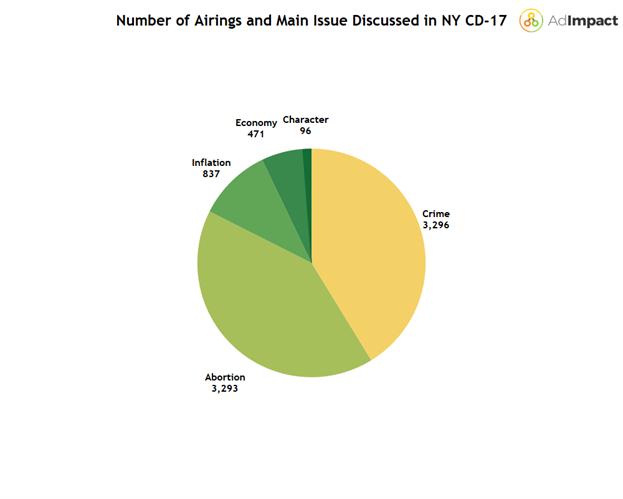
Similar to abortion, the issues of crime and inflation also became more prevalent this election cycle. For example, 15% of all political ads this cycle mentioned crime, up from being the primary message in only 5% of political ads in 2020. Additionally, as inflation became an issue early in 2022, it quickly shot up to become one of the top issues this election. Twelve percent of all ads this cycle mentioned inflation. Lawler, alongside other Republicans, heavily campaigned on the issues of crime and inflation. Eighteen percent of all of the NRCC’s and Congressional Leadership Fund’s ads were about crime, and 27% were about inflation.
NY CD-17 was not the only Congressional race in New York that Republicans overperformed in. For more about those races, you can read our New York Congressional Spending Deep Dive.
